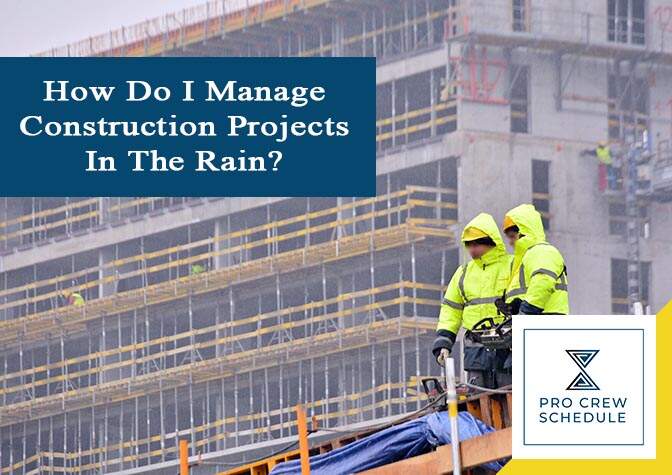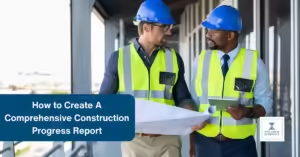Managing construction projects is a huge responsibility on its own. On top of making sure the project progresses without a hitch, you have the safety of everyone on your mind, yours included. But things get extra tough when weather conditions are not so favorable.
While it is challenging to take on projects when the rain is pouring, construction must go on to meet deadlines and keep the client happy. Below are the challenges to expect during the rainy season, plus some tips to help you get through it.
Challenges Of Working Construction In The Rain
1. Delays
Delays are arguably the most significant problem onsite, especially when the rainy season hits. They are a result of other things going wrong and can significantly affect construction. Delays can even cost the project a loss in revenue and an increase in expenditures.
Delays may be inevitable, but planning can help in lessening the risk of it.
2. Safety
Aside from delays, safety is one of the top concerns in construction, which is even more compromised when it starts to pour. The construction business is already a dangerous industry, but the rain makes it more so, making surfaces slippery and obscuring vision. Prolonged exposure to the cold and wet can also result in other health issues, such as colds, pneumonia, and fever.
3. Cracks and morphs in wood frames
The rain will also do some damage to the structure itself. Because untreated wood soaks up water, the moisture can cause wooden frames to crack, morph, and swell. In the long run, a warped frame from the start can lead to a poor foundation and eventual leaks, among other problems.
4. Fitted structures don’t fit.
Accuracy in measurements is vital in this field. Unfortunately, morphing and warping from rain damage can cause fitted structures, like window frames and doors, to not fit as it was designed. An ill-fitting structure lacks a tight seal, resulting in high cooling and heating bills due to leaks and drafts.
4. Erosion and structure resettling due to loose soil
Stability is essential in building the foundations, but the rain can compromise that. Heavy rains can wash away massive amounts of soil that are needed to keep the foundation stable.
When the ground dries, it could resettle unevenly. This will lead to weakened walls, foundation cracks, and expensive and time-consuming repairs.
5. Rusting on metal materials
Metal support structures are generally more stable and durable than wooden ones. However, being exposed to rain and moisture early on can have a damaging effect over time, specifically rust. Rust can weaken the structure and is much a problem to the metal as warping is to wood.
Construction Site Safety Tips For Construction In The Rain
1. Plan ahead
The saying “prevention is better than cure” is very applicable in the construction industry, significantly when heavy rains threaten risk safety and progress. Weather is unpredictable, so you and your team should always be prepared. Have protective sheets to place on scaffolding, a dry area to store tools, and remove any loose tools items. When you or anyone senses bad weather coming, the team can quickly act and cover what needs to be protected and what needs to be secured.
Moreover, having a water damage response plan is a wise thing to have when working. When a water issue is identified, it can immediately be dealt with before it becomes a bigger problem.
2. Use a professional weather forecasting service.
A professional weather forecasting service is a useful tool. Although the weather is unpredictable, it becomes less so with this kind of tool as it monitors and predicts the weather, giving you time to prepare and adjust schedules.
A good weather forecasting service should provide satellite imagery and send you mobile alerts of impending storms so contractors like you can be informed and up-to-date on local weather.
3. Wear waterproof gear and other protective equipment
Dressing appropriately is the simplest yet best way to combat inclement weather. First of all, you and your tea must be equipped with waterproof gear to keep you dry, such as raincoats and waterproof boots and gloves that provide a slip-proof grip, as the rain makes surfaces slippery. Goggles also prevent the rain from affecting your vision.
Rain also means cooler temperatures. Layers of clothing will help keep you and your crew warm and also prevent anyone from catching a cold. But because construction works heavily relies on mobility, make sure that you are wearing clothes that allow movement.
4. Be wary of lightning strikes.
Construction sites are prone to lightning strikes as metal is often exposed. So, during thunderstorms, advise your crew to keep an eye out for lightning strikes and be careful when working near any metal.
5. Be cautious of live wires
On a typical day, electrocution is already a significant safety hazard onsite. But when the weather is wet, it increases the risk of dangerous live wires. While you should, of course, be cautious around live wires, your awareness should be sharp to alert others of electrical cables that may be live during rainy days.
6. Avoid potential cave-ins
Rainy weather can negatively impact the stability of a trench, making it more vulnerable to cave-ins. This usually happens in small projects, like wells and drains excavation, because safeguards against collapses are rarely required as people think these jobs are not hazardous enough.
Be that as it may, it’s better to be on the safe side. Avoid entering trenches deeper than 4 feet and are not properly shored, sloped, or protected by a trench box unless the walls are solid rock.
7. Move cautiously
The wet weather would probably push your team to work hurriedly to get things done quickly and get out of it. The downside to that is they are increasing the risk of danger. As it was mentioned, the rain makes surfaces slippery, increasing the chances of slipping and falling. As a project manager or contractor, encourage your team to work slowly yet deliberately.
8. Protect the equipment
Besides the crew’s safety, the equipment could also be damaged by the rain. Malfunctioning equipment could result in significant delays as work has to stop for repairs temporarily or to find replacements.
Tarps are an effective yet inexpensive way to keep the equipment dry and safe. The same can happen for tools, equipment, and supplies. Tarps make for an excellent cover, but be sure to invest in high-quality ones with grommets for easy set-up.
9. Handle construction tools with extra care
The rain makes handling tools more difficult and dangerous because they become slippery. As a word of caution, don’t let your crew use tools that are not specifically rated for outdoor use in the rain. They should also take extra care when working with them.
It’s also a wise choice to invest in the right kinds of tools and materials. Selecting waterproof ones with textured and non-grip handles might be pricey but will be beneficial in the long run.
10. Make sure you can see
Obscured vision is another big problem the rain brings. When a worker cannon see, they might be doing something wrong and risk their safety, as well as everyone else’s. It can also be trouble for you, as you might be overlooking some issues.
While wearing goggles does help a lot, it’s not enough and can even be more dangerous. So, if anyone in your crew wears glasses or goggles, tell them to coat their eyewear with anti-fog spray or wipes.
A hood can also be a good addition. But because it narrows the vision, be sure to look both ways first. Good lighting is also essential for working at night.
11. Ensure you are visible
As the rain can distort vision, a crew member may not be seen, making them susceptible to accidents or may not immediately be helped if caught in one. So, during the rainy season, tell them to dress in high-visibility clothing. As a project manager or contractor, you should also allot a budget and provide them with neon reflective vests. Don’t allow them to wear ones that are dull and not reflective anymore.
12. Use construction management software.
Construction management software is always a helpful tool, but it becomes particularly essential on a rainy day. Contractors can remotely adjust construction schedules according to the weather, keep track of their crew, and effectively monitor materials and resources.
Pro Crew Schedule’s project management software offers features that improve efficiency. Management can easily schedule and manage tasks, modify them accordingly. It even has a time tracker for the whole company. With digital sheets, crew leaders can input time with approval from supervisors. Plus, it’s cloud-based, which means you can store and share important documents instantly. And with it being completely mobile, you can take it wherever you go.
Responsibilities of the Construction Management
Being part of the management team is not an easy role to fulfill. While you may not be doing the heavy lifting, you are responsible for making sure everything stays on track. That becomes especially hard when factors, such as weather conditions, throw off the plan. As a leader, you should be ready to face these challenges and guide your crew through a successful project.







